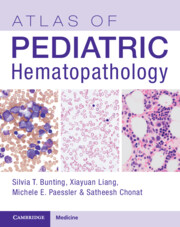Book contents
- Atlas of Pediatric Hematopathology
- Atlas of Pediatric Hematopathology
- Copyright page
- Contents
- Contributors
- Section I Peripheral Blood
- Section II Normal and Non-neoplastic Hematolymphoid Diseases
- Section III Mature Lymphoid Neoplasm
- Section IV Precursor Hematopoietic Neoplasms and Related Neoplasms
- Chapter 13 Precursor Lymphoblastic Leukemia/Lymphoma
- Chapter 14 Blastic Plasmacytoid Dendritic Cell Neoplasm
- Chapter 15 Acute Myeloid Leukemia and Related Precursor Neoplasms
- Chapter 16 Myeloproliferative Neoplasms
- Chapter 17 Myelodysplastic/Myeloproliferative Neoplasms
- Chapter 18 Childhood Myelodysplastic Syndrome
- Chapter 19 Germline Predisposition to Myeloid Neoplasia
- Chapter 20 Germline Predisposition to Lymphoid Neoplasm
- Chapter 21 Mastocytosis and Myeloid Lymphoid Neoplasms with Eosinophilia
- Section V Histiocytic Neoplasm and Miscellaneous Bone Marrow Diseases
- Index
- References
Chapter 18 - Childhood Myelodysplastic Syndrome
from Section IV - Precursor Hematopoietic Neoplasms and Related Neoplasms
Published online by Cambridge University Press: 25 November 2023
- Atlas of Pediatric Hematopathology
- Atlas of Pediatric Hematopathology
- Copyright page
- Contents
- Contributors
- Section I Peripheral Blood
- Section II Normal and Non-neoplastic Hematolymphoid Diseases
- Section III Mature Lymphoid Neoplasm
- Section IV Precursor Hematopoietic Neoplasms and Related Neoplasms
- Chapter 13 Precursor Lymphoblastic Leukemia/Lymphoma
- Chapter 14 Blastic Plasmacytoid Dendritic Cell Neoplasm
- Chapter 15 Acute Myeloid Leukemia and Related Precursor Neoplasms
- Chapter 16 Myeloproliferative Neoplasms
- Chapter 17 Myelodysplastic/Myeloproliferative Neoplasms
- Chapter 18 Childhood Myelodysplastic Syndrome
- Chapter 19 Germline Predisposition to Myeloid Neoplasia
- Chapter 20 Germline Predisposition to Lymphoid Neoplasm
- Chapter 21 Mastocytosis and Myeloid Lymphoid Neoplasms with Eosinophilia
- Section V Histiocytic Neoplasm and Miscellaneous Bone Marrow Diseases
- Index
- References
Summary
Myelodysplastic syndrome (MDS) is a heterogeneous group of clonal disorders characterized by ineffective hematopoiesis causing cytopenias, dysplastic morphology, and risk for progression to acute myeloid leukemia (AML) [1]. Sporadic MDS is typically a disease of the elderly, whereas, in the pediatric population, the annual incidence is very low with one to two cases per million [2]. Pediatric MDS constitutes less than 5% of childhood hematologic malignancies [3].
- Type
- Chapter
- Information
- Atlas of Pediatric Hematopathology , pp. 198 - 206Publisher: Cambridge University PressPrint publication year: 2023

